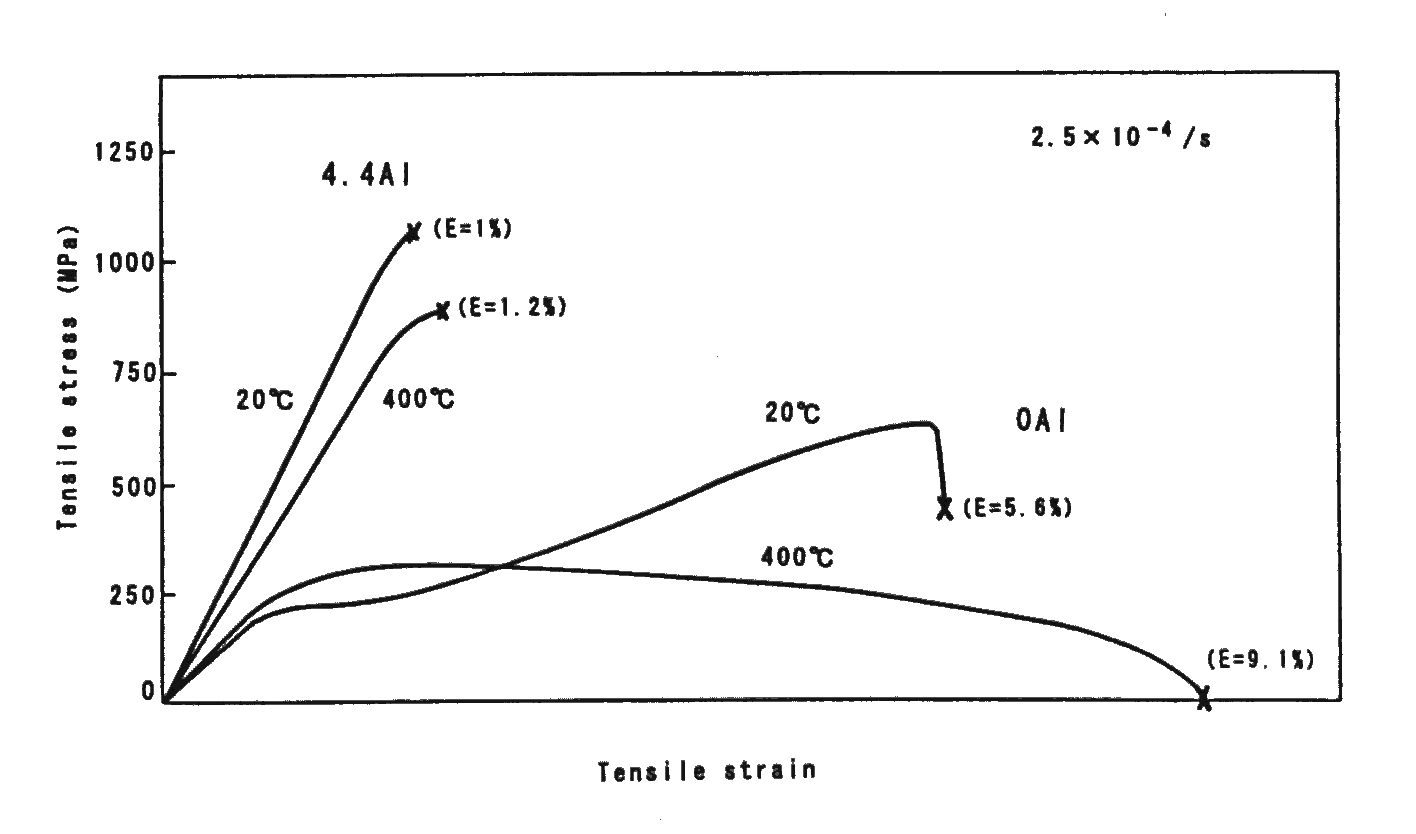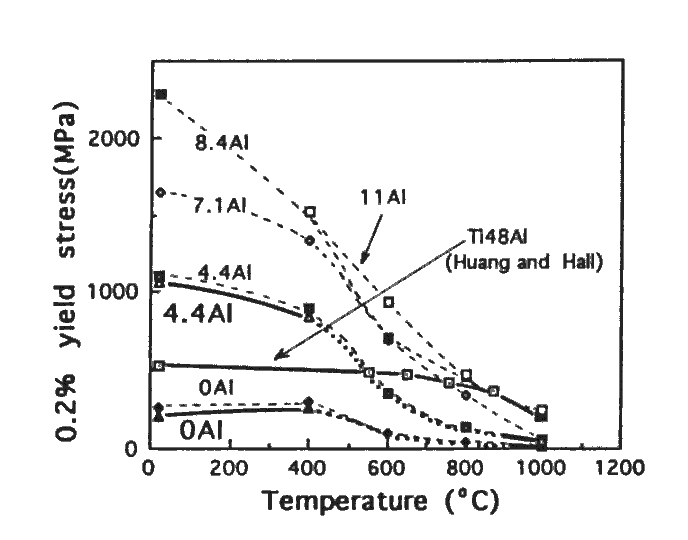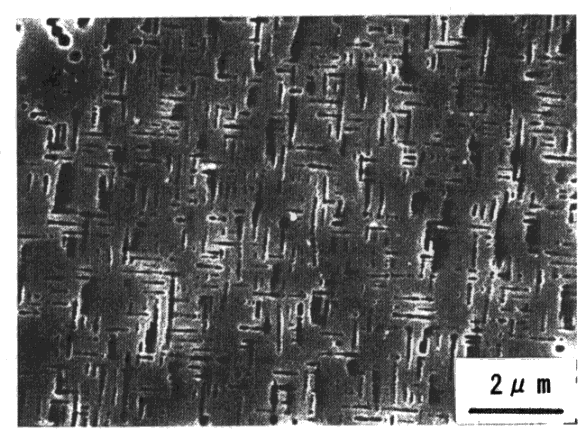NiTi-base Intermetallic Alloys Strengthened by Al Substitution
- ABSTRACT -
Y.Koizumi, Y.Ro, S.Nakazawa and H.Harada
National Research Institute for Metals
1-2-1 Sengen, Tsukuba city, Ibaraki 305, JAPAN
Published in Proceedings of
"Symposium onAtomic Arrangement Design and Control for New Materials"
held at NRIM, November 16,1994, pp.36-37.
1.Introduction.
The materials used in jet engine blades and disks,as well as fuselage materials,are subject to extreme temperature gradients.For example in turbine disks,the outer material may experience temperatures exceeding 600 deg.C which the inner material may be a relatively cool 200 deg.C.Therefore the materials used in these areas must be strong over a wide temperature range.Currently these materials are nickel-base superalloys which have high strength at high temperatures but relatively low temperatures.These alloys alos have high specific weights which increase the centrifugal stresses at the inner areas as well as increasing the overall componant weight.
The purpose of this study was to investigate the feasibility of designing and developing new alloys to replace nickel-base superalloys.particularly in turbine disks.This was done by examining the high-temperature strength of nickel-titanium(NiTi) alloys,which have been known as shape-memory alloys.Particular attention was paid to the coherent precipitation of Ni2AlTi 1,2in alloys produced by substituting a portion of the Ti in NiTi alloys with Al.
2. Experimental.
A total of 7 alloys were used.In each a portion of the Ti in NiTi was replaced with Al thus following the pseudo-binary tie-line brtween NiTi(B2 or beta2 phase)and Ni2AlTi(Heusler-type or beta-prime phase).
The mechanical properties of the as-cast materials were determined by a combination of compression tests and tensile tests.The effect of solution and ageing heat treatments was monitored by Vickers hardness tests.Microstructural observations were made with a scanning electron microscope using both as-cast and heat-treated materials etched with aqua regia.
3. Results and Discussion.
3.1 Machinability and microstructure of cast materials
Lathe processing was only possible for alloys containing up to 8.4% Al thus restricting the preparation of threaded tensile-test apecimens.A spark cutter was used to made cylindrical compression test specimens instead.SEM characterisation of the microstruture found that the beta-prime phase occurs as primary dendrites for the higher aluminium content alloys thus making these materials rather brittle.Future processing methods should be carefully considered when selecting the alloy aluminium content.
3.2 characteristics of mechanical properties
Room temperature compression tests showed that the 0% Al alloy has ductility but not much strength.Increasing the Al content increased the strength but decreased the ductility. Compression tests at 1000 deg.C showed a peak in the strength at around 11.0% Al.This strength peak corresponds to the two-phase region of beta2+beta-prime and closely resembles the strength peak shown by nickel-base superalloys 3 in the two-phase region of gamma+gamma-prime.The tensile test stress strain curves (Figure 1) show that the 4.4% Al alloy still has 1% ductility at room temperature. Considering the existence of casting defects in these specimens, we can say that this NiTi/Ni2AlTi alloy system, especially at low Al content, has reasonable tensile ductility.
Figure 2 summarises the results of the compression and tensile tests.The tensile test results almost perfectly match the compression test results. For comparison, the tensile test data for a TiAl alloy 4 is also shown. At high temperatures,the test alloys were equal to the TiAl alloy, But at low temperatures the test alloys were far stronger. Also, at 100 deg.C, there is about the same degree of strength in these test alloys as there is in mid-grade current superalloys, such as U500 and U700.
3.3 Effects of heat treatment
The data from compression tests in this study are all from as cast materials. To further improve the strength preliminary solution and aging treatments were investigated. Photo 1 shows 7.1% Al material solution treated and aged for 100hrs at 800 deg.C. A fine dipersion of beta-prime Ni2TiAl precipitates can be seen. Hardness measurements suggest that this microstructure is already overaged. Further optimisation is likely to be possible.
Refernces
1) P.Nash and W.W.Liang: Metall. Trans. A, 16A, March(1985), 319.
2) W.J.Boettinger, L.A.Bendersky, F.S.Biancaniello and J.W.Cahn: Mater. Sci. Eng, 98(1988), 273.
3) H.Harada, M.Yamazaki and Y.Koizumi: Tetsu to Hagane, 65(1979), 1049.
4) S.C.Huang and E.L.Hall: Metal. Trans. A, 22A, Feb.(1991), 427.

Fig.1Stress-strain curve by tensile test.

Fig.2Yield strees of the alloys by compression test (Broken lines) and tensile test (Solid lines).

Photo.1SEM micrograph showing beta-prime (Ni2TiAl) precipitates in beta2(NiTi) matrix.
go to Ni-Ti High Temp Alloy
go to High Temperature Materials 21 Project Home Page


